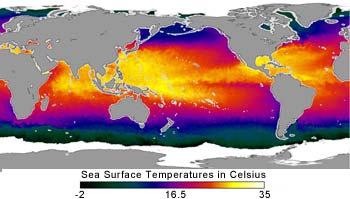Ocean Sponging up Some Warmth Over Next 50 Years

GLOBAL SEA SURFACE TEMPERATURES <br> <br>This is an image of global sea surface temperatures taken from Japan National Space Development Agency’s (NASDA) AMSR-E instrument aboard NASA’s Aqua spacecraft on August 27, 2003. The colors in this false-color map represent temperatures of the ocean’s surface waters, ranging from a low of -2°C (28°F) in the darkest green areas to a high of 35°C (95°F) in the brightest yellow-white regions. Sea ice is shown as white and land is dark gray. CREDIT: NASDA/NASA
NASA’s improved global climate computer model, which simulates and projects how the Earth’s climate may change, indicates that the oceans have been absorbing heat since 1951 and will continue to absorb more heat from the atmosphere over the next 50 years. This increasing ocean heat storage suggests that global surface temperatures may warm less than previous studies projected, while the ocean acts as a bigger heat sponge. Further, such additional ocean heating would likely change regional climate patterns.
Shan Sun and James Hansen, both of NASA’s Goddard Institute for Space Studies, New York, NY, used NASA’s Global Climate Model (GCM), one of the world’s leading computer climate models that simulate past and potential future climate changes. The GCM has been enhanced with new “ocean models” that better simulate how oceans currently absorb heat and will respond to a warming global climate. The study appears in the latest issue of the American Meteorological Society’s Journal of Climate.
One of the leading reports on climate change, the Intergovernmental Panel on Climate Change (IPCC) report of 2001, suggests that between the years 1990 and 2100 the world’s average temperature will rise between 0.6 and 2.5 degrees Celsius (C) or 1.1 and 4.5 Fahrenheit (F). “The enhanced GCM shows that the average global temperature would rise between 0.4 and 1.2 C (between 0.7 and 2.2 F) through the year 2050, for plausible increases of greenhouse gases,” Sun said.
Scientists measure ocean heat storage in Watts per meter squared, the rate of heating a square meter area. For example, a miniature Christmas tree bulb dissipates about 1 Watt of energy, so one bulb over every square meter would heat at a rate of 1 Watt per meter squared.
The enhanced GCM showed the world’s oceans were storing heat at a rate of about 0.2 Watts per square meter in 1951, and in the past 50 years, as atmospheric temperatures warmed, the rate of heat storage increased to about .75 Watts per square meter, capturing more heat from the atmosphere. “This increase in ocean heat storage shows that the planet is out of energy balance,” Hansen said. “This energy imbalance implies that the atmosphere and ocean will continue to warm over time, so we will see continuing climate change.”
It is important to know accurately how much heat oceans are storing, because the amount of heat stored provides a measurement of the Earths energy imbalance and indicates how much global temperature may increase in the future. It’s also important to see where heat is increasing in the world’s oceans, in order to predict climate changes in various geographical regions.
Sun and Hansen also looked at changes of precipitation and ocean currents, other factors that warmer world-wide waters may impact. If greenhouse gases continue to increase rapidly, the model projects significant ocean warming during the next 50 years in the Eastern Pacific Ocean, off the U.S. west coast, which could have biological consequences for ocean life.
The results also project increased precipitation and evaporation over the North Atlantic Ocean, increasing the fresh water in the region. An increase in freshwater has long been suspected as something that could weaken the northward transport of heat by the Atlantic Ocean, thus causing Europe to become cooler, even while the world becomes warmer. Sun and Hansen find, however, that the ocean circulation does not weaken significantly according to their model, so they expect no cooling effect on Europe.
More monitoring of ocean temperatures is needed to further the studies of ocean behavior. Ocean temperature readings currently do not reach full ocean depths, as is needed to increase the accuracy of future predictions.
With the new Ocean Models included in the GCM, if easurements of the amount of heat held by oceans are improved, it may be possible to begin to better quantify the Earth’s changing radiation imbalance and its causes with an accuracy of about one decade.
This study was funded through NASA’s Earth Science Enterprise under NASA’s Climate and Oceanography Programs. The mission of NASA’s Earth Science Enterprise) is to develop a scientific understanding of the Earth system and its response to natural or human-induced changes to enable improved prediction capability for climate, weather, and natural hazards.
Media Contact
More Information:
http://www.gsfc.nasa.gov/topstory/2003/0901oceansponge.htmlAll latest news from the category: Earth Sciences
Earth Sciences (also referred to as Geosciences), which deals with basic issues surrounding our planet, plays a vital role in the area of energy and raw materials supply.
Earth Sciences comprises subjects such as geology, geography, geological informatics, paleontology, mineralogy, petrography, crystallography, geophysics, geodesy, glaciology, cartography, photogrammetry, meteorology and seismology, early-warning systems, earthquake research and polar research.
Newest articles

Silicon Carbide Innovation Alliance to drive industrial-scale semiconductor work
Known for its ability to withstand extreme environments and high voltages, silicon carbide (SiC) is a semiconducting material made up of silicon and carbon atoms arranged into crystals that is…

New SPECT/CT technique shows impressive biomarker identification
…offers increased access for prostate cancer patients. A novel SPECT/CT acquisition method can accurately detect radiopharmaceutical biodistribution in a convenient manner for prostate cancer patients, opening the door for more…

How 3D printers can give robots a soft touch
Soft skin coverings and touch sensors have emerged as a promising feature for robots that are both safer and more intuitive for human interaction, but they are expensive and difficult…




















